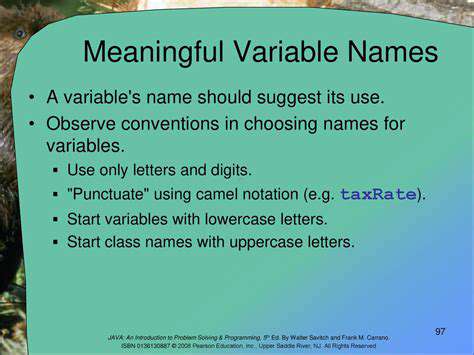How to Write Clean, Readable Code


Utilizing Code Structure and Organization
Modular Design for Readability
Breaking down complex tasks into smaller, self-contained modules is crucial for writing clean and readable code. Each module should have a specific, well-defined purpose, making the overall program structure easier to understand and maintain. This modular approach promotes code reusability, as modules can be reused in different parts of the program or even in other projects. Clear separation of concerns is a key benefit, allowing developers to focus on individual components without getting bogged down in the intricacies of the entire system.
Consider using functions or classes to encapsulate specific functionalities. This not only improves readability but also enhances the maintainability and testability of your code. Thorough documentation within each module, explaining its purpose and usage, is essential for long-term collaboration and understanding.
Meaningful Variable and Function Names
Choosing descriptive variable and function names is paramount to code readability. Avoid abbreviations and cryptic names that obscure the purpose of the code element. Instead, opt for names that clearly communicate the role of the variable or function. For instance, instead of using 'cnt' for a counter, use 'itemCount' or 'counter'.
Consistent naming conventions across the project further enhance readability. Adhering to a consistent naming standard ensures that the codebase is easy to navigate and understand, regardless of the specific module being reviewed. This helps in maintaining a uniform coding style and avoids confusion.
Comments for Clarity
Well-placed comments can significantly improve the readability of your code, especially for complex algorithms or logic. Comments should explain the *why* behind the code, not just the *what*. Avoid redundant comments that simply restate the obvious. Focus on explaining the rationale behind specific decisions or highlighting critical logic flow.
Comments should be concise and focused on the important aspects of the code. Avoid using comments to explain poorly written code; instead, refactor the code to be more readable and maintainable. Comments should enhance understanding, not obscure it.
Consistent Formatting and Indentation
Employing consistent formatting and indentation is crucial for creating a visually appealing and readable codebase. A standard formatting style ensures that the code is easy to scan, and the logical flow is readily apparent. Tools like linters and code formatters can automatically enforce formatting standards, saving you time and ensuring consistency.
Using Whitespace Effectively
Strategic use of whitespace, including blank lines and proper indentation, improves code readability. Blank lines separate logical blocks of code, making it easier to parse the program structure. Proper indentation visually represents the hierarchy of code blocks, enhancing the overall comprehension of the program's flow.
Code Structure for Maintainability
Organizing code into logical blocks, like classes, functions, and modules, promotes maintainability. This modular approach allows developers to modify specific components without affecting other parts of the program. Following a well-defined structure enhances collaboration, as different developers can work on different parts of the codebase concurrently without significant interference.
A well-structured codebase is easier to debug, as problems are often localized to specific modules or functions. This reduces the overall time and effort needed to identify and fix bugs.
Error Handling and Logging
Implementing robust error handling mechanisms is vital for writing reliable code. This involves anticipating potential errors and providing appropriate responses to mitigate negative impacts. Effective error handling involves catching exceptions, logging errors for analysis, and providing informative feedback to the user. Proper logging mechanisms provide valuable insights into the program's execution, helping in debugging and troubleshooting.
Logging not only aids in debugging but also provides crucial information about the program's behavior during runtime. Comprehensive logging enables developers to monitor the application's performance, detect anomalies, and identify potential issues before they escalate.
Read more about How to Write Clean, Readable Code
Hot Recommendations
- Review: The New [Specific Brand] Smart Lock Is It Secure?
- Best Budget Studio Monitors for Music Production
- Top Flight Simulation Peripherals (Joysticks, Throttles, etc.)
- Top Portable Scanners for Document Management On the Go
- Reviewing the Latest Smart Air Purifiers for Your Home
- Best Portable Photo Printers for Travelers and Memory Keepers
- The Future of Personal Transportation Beyond Cars (Hyperloop, eVTOL)
- Top Network Monitoring Tools [Free & Paid Options]
- Understanding the Tech Behind mRNA Vaccines [A Look Inside]
- Guide to Choosing the Right Gaming Chair for Ergonomics


![How to Automate Your Workflow with [Automation Tool]](/static/images/25/2025-05/OptimizingYourZapsforEfficiency.jpg)








